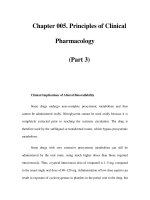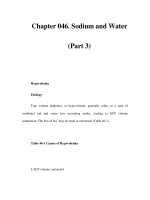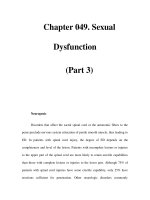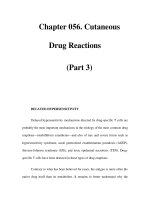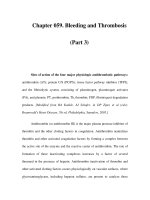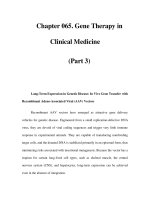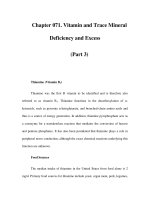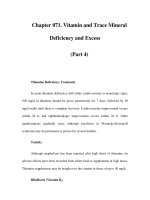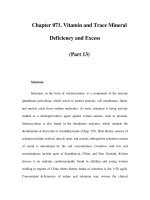Chapter 123. Clostridium difficile–Associated Disease, Including Pseudomembranous Colitis (Part 3) docx
Bạn đang xem bản rút gọn của tài liệu. Xem và tải ngay bản đầy đủ của tài liệu tại đây (13.85 KB, 5 trang )
Chapter 123. Clostridium difficile–Associated Disease,
Including Pseudomembranous Colitis
(Part 3)
Table 123-
1 Relative Sensitivity and Specificity of Diagnostic Tests for
Clostridium difficile–Associated Disease (CDAD)
Type of Test Relative
Sensitivity
a
Relative
Specificity
a
Comment
Stool culture
for C. difficile
++++ +++
Most sensitive test;
specificity is ++++ if the
C. difficile
isolate tests
positive for toxin; with
clinical data, is diagnostic
of CDAD
Cell culture
cytotoxin test on stool
+++ ++++
With clinical data,
is diagnostic of CDAD;
highly specific but not as
sensitive as stool culture
Enzyme
immunoassay for
toxin A or toxins A
and B in stool
++ to
+++
+++
With clinical data,
is diagnostic of CDAD;
rapid results, but not as
sensitiv
e as stool culture
or cell culture cytotoxin
test
Latex test for
C. difficile
antigen in
stool
++ +++
Detects glutamate
dehydrogenase found in
toxigenic and
nontoxigenic strains of
C.
difficile
and other stool
organisms; less sensitive
and specific than
other
tests; rapid results
Colonoscopy
or sigmoidoscopy
+ ++++
Highly specific if
pseudomembranes are
seen; insensitive compared
with other tests
a
According to both clinical and test-based criteria.
Note: ++++, >90%; +++, 71–90%; ++, 51–70%; +, ~50%.
Despite the array of tests available for C. difficile and its toxins (Table 123-
1), no single test has high sensitivity, high specificity, and rapid turnaround. The
turnaround time for reporting of a positive result in the cell cytotoxicity test can be
shortened to <24 h if cell cultures are examined at intervals as short as 4 h.
However, this approach is labor intensive, and observation for 48 h is required for
a conclusive test result. Most laboratory tests for toxins lack sensitivity. However,
testing of multiple additional stool specimens is not recommended. Empirical
treatment is appropriate if CDAD is strongly suspected on clinical grounds.
Testing of asymptomatic patients is not recommended except for epidemiologic
study purposes. In particular, so-called tests of cure following treatment are not
recommended because many patients continue to harbor the organism and toxin
after diarrhea has ceased and test results do not always predict recurrence of
CDAD. Thus these results should not be used to restrict placement of patients in
long-term-care or nursing home facilities.
Clostridium difficile–Associated Disease: Treatment
Primary CDAD
When possible, discontinuation of any ongoing antimicrobial
administration is recommended as the first step in treatment of CDAD. Earlier
studies indicated that 15–23% of patients respond to this simple measure.
However, with the advent of the current epidemic strain and the associated rapid
clinical deterioration of some patients, prompt initiation of specific CDAD
treatment has become the standard. General treatment guidelines include hydration
and the avoidance of antiperistaltic agents and opiates, which may mask symptoms
and possibly worsen disease. Nevertheless, antiperistaltic agents have been used
safely with vancomycin or metronidazole for mild to moderate CDAD.
